Recent Articles
Popular Makes
Body Types
2023 Ford Bronco Sport Road Test and Review
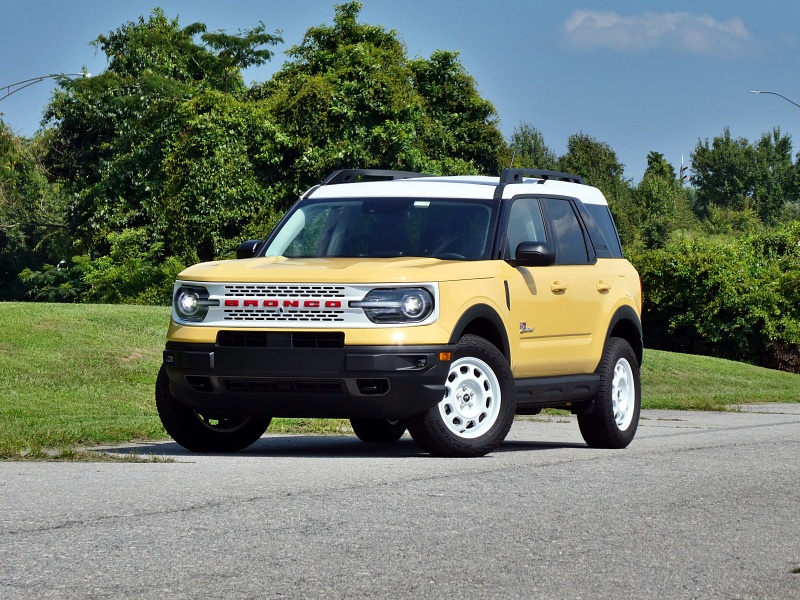
Photo by Brady Holt
Ever since automakers discovered that people liked SUVs for more than going off road, every new model has been a balancing act. How much capability should it give up in exchange for everyday comfort, fuel efficiency, and drivability, and vice versa?
The 2023 Ford Bronco Sport tries to minimize the compromise. This compact crossover brings classic SUV styling and character and above-average off-roading chops. But with its passenger-car roots, it also promises to excel on the pavement. This is a combination that has quickly made the Bronco Sport one of Ford’s best-selling SUVs. We just spent a week testing the Bronco Sport to learn more about this retro crossover’s pros and cons and see how it stacks up against a variety of competitors. Keep reading to learn whether this sounds like the right small SUV for you.
Not the Big Bronco
In 2021, Ford brought back two of its old SUV nameplates: First is the Ford Bronco, which had been one of the first SUVs on the market back in 1966. The reintroduced Bronco is a mid-size body-on-frame SUV that’s currently priced from $34,890 as a two-door model and $38,040 as a four-door. This is a heavy-duty truck with a convertible top and removable doors that goes toe-to-toe with the Jeep Wrangler for the off-road market.
But today, we’re talking about the Ford Bronco Sport, which shares nothing but its name and some styling cues with the big Bronco. This is a compact crossover that shares its bones (and its sub-$30,000 starting price) with the front-wheel-drive-based Ford Escape. Ford has a Bronco for all tastes, and this Bronco Sport is for folks who don’t need to tackle the very roughest trails.
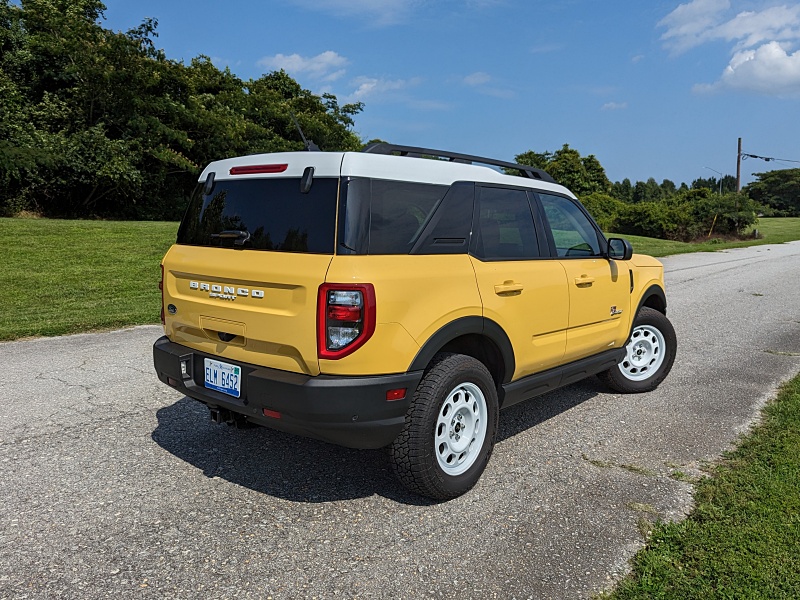
Photo by Brady Holt
Retro Looks
The Ford Escape began its life as a boxy crossover before becoming the gently rounded model sold today. With its squared-off shape and rounded headlight elements, the Bronco Sport is a cross between a 15-year-old Escape and a 50-year-old Bronco.
Our tested Heritage Limited plays up the latter with a white roof, grille, and wheels that offset its Yellowstone Metallic paint. And every Bronco Sport has great big Bronco badging (either lettering or a horse logo) on the front, rear, steering wheel, and dashboard screens. But aside from the headlights themselves, the Bronco Sport could be simply a modern SUV that looks purposeful instead of aerodynamic. Vertical front and rear ends are unusual on modern vehicles, giving the Bronco Sport presence. It has very different proportions from its Escape cousin, too: The Escape is 8 inches longer while the Bronco Sport is 4 inches taller. Especially in a bright color, you won’t lose your Bronco Sport in a parking lot.
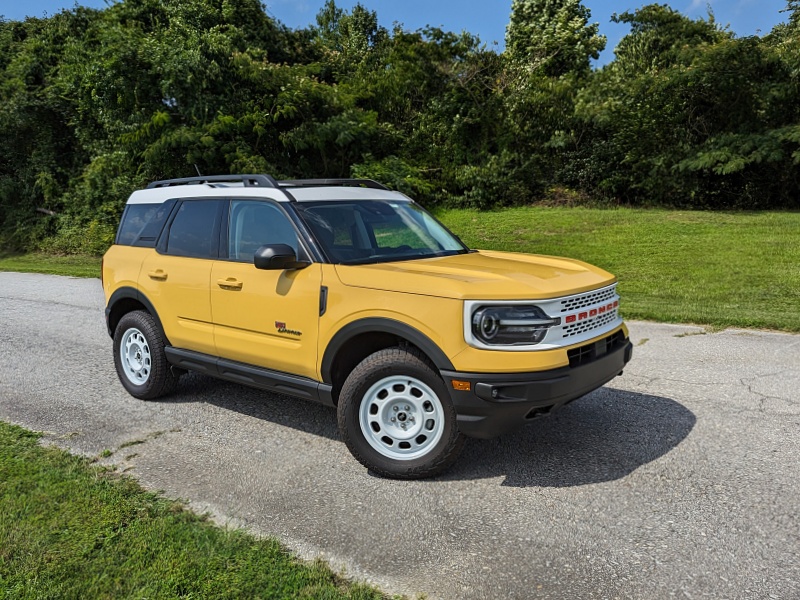
Photo by Brady Holt
Modern But Rugged Interior
The Bronco Sport’s interior isn’t as unusual as its interior. We mentioned that its screens – an 8-inch touchscreen on the dashboard and a 6.5-inch display between the gauges – flash with Bronco logos and tumbling rocks. But otherwise, the Bronco Sport’s cabin focuses on ergonomic simplicity over stylistic flair.
We do appreciate how the cabin feels sturdy without coming across as cheap and basic. Clever cues include a textured but padded dashboard, zippered pockets on the front seatbacks, and a rubber-lined cargo hold. There’s no piano black, false wood, or shiny silver in this cabin. It has the ambiance of a high-end camping backpack, and we mean that in a good way. Our test vehicle’s brown plaid-patterned leather upholstery also managed to be rich-feeling without feeling flimsy or froufrou. Folks loving a digital experience will pine for the bigger touchscreens that you’ll find in the Escape and the big Bronco, but others will appreciate the Bronco Sport’s simpler vibe.
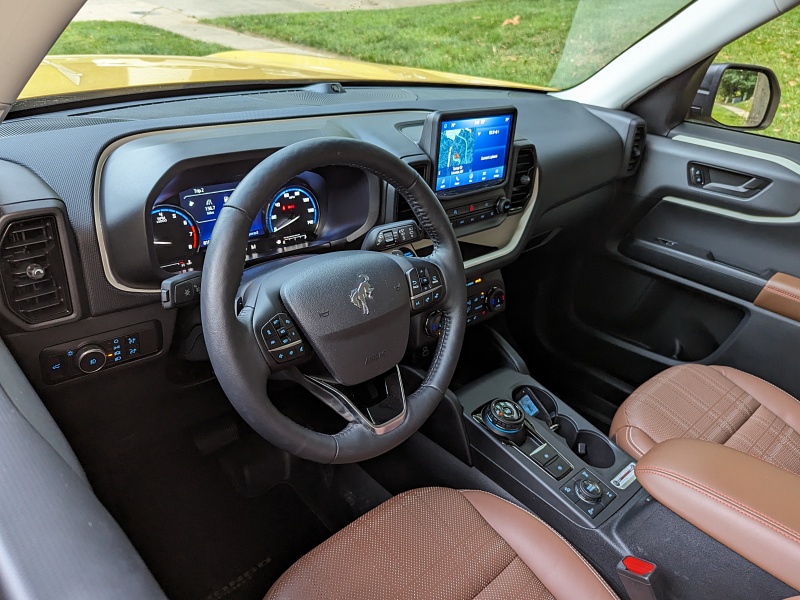
Photo by Brady Holt
Comfortable, But a Bit Cozy
We mentioned that the Escape is 8 inches longer than the Bronco Sport. At just 173 inches long, the Bronco Sport is sized more like some subcompact crossovers than compact ones. And you feel that inside the cabin.
The high roof means the Bronco Sport offers plenty of headroom in the front and rear. And the seat cushions are high and generously padded, if not super wide. But the backseat doesn’t have a lot of extra legroom. Cargo capacity measures 32.5 cubic feet behind the rear seat and 65.2 cubic feet with the backseat folded down. That’s modest for a compact crossover, and you have to stack your stuff to the ceiling to make full use of that capacity. But SUVs are inherently useful, and we think the Bronco Sport will be big enough for many people’s lives. We also appreciated the adjustable-height cargo floor, which you can lower for maximum cargo capacity or raise to create a flush surface with the folded seatbacks. The Bronco Sport also restored a beloved feature from the pre-2013 Escape: You can open the rear windshield glass to quickly grab something from the back without opening the entire tailgate.
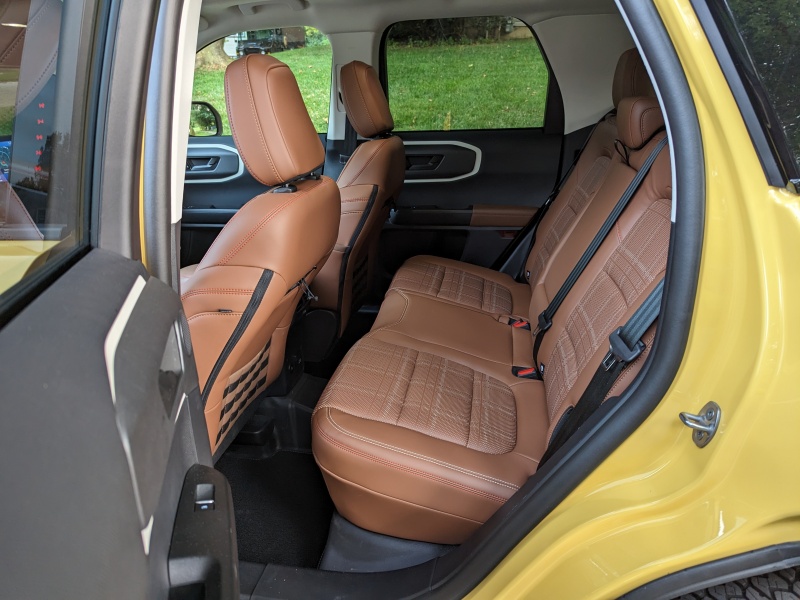
Photo by Brady Holt
Choice of Turbo Engines
The Bronco Sport comes with a choice of two peppy yet fuel-efficient turbocharged engines, which it shares with the Escape. Most models have a 1.5-liter three-cylinder making 181 horsepower and 190 lb-ft of torque. This three-cylinder zips off the line with a pleasant growl, and it manages an EPA-estimated 25 mpg in the city, 28 mpg on the highway, and 26 mpg combined with its standard all-wheel drive. That’s a couple mpg behind the Escape, but we did average 30 mpg when we last tested a three-cylinder model.
Our latest Heritage Limited test vehicle, along with the off-road-focused Badlands, comes with a 2.0-liter four-cylinder making 250 hp and 277 lb-ft of torque. This engine is quicker but understandably thirstier than the three-cylinder. The EPA pegs it at a mere 21 mpg city, 26 mpg highway, and 23 mpg combined, though we once again beat estimates to get 28 mpg – excellent for such a powerful little SUV. Three-cylinder Escapes can tow up to 2,000 pounds while four-cylinders can handle up to 2,200 pounds; the latter is less than an equivalent Escape. You also can’t get the Bronco Sport with the Escape’s extra-efficient hybrid versions.
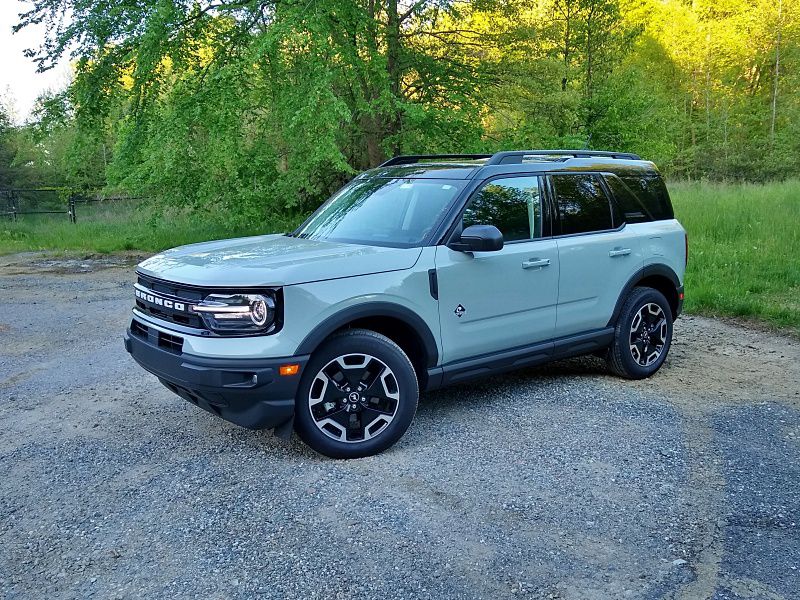
Photo by Brady Holt
Capable, Comfortable, and Fun to Drive
The Bronco Sport’s classic-SUV body makes promises about its off-road capability, and while it won’t come close to a big Bronco, the Sport does well for a crossover. Its G.O.A.T. (goes over any terrain) driving modes include settings for slippery and sandy conditions on all models, while the Heritage Limited and the off-road-focused Badlands get Rock Crawl and Mud/Ruts modes as well. Those vehicles also get an off-road suspension, skid plates, and a more advanced four-wheel-drive system that can send torque to a single rear wheel. It’s also rated to ford up to 23.6 inches of water, has an 8.8-inch ground clearance, and has bumpers sculpted to avoid catching on obstacles.
Yet despite all this capability, the Bronco Sport is a comfortable crossover to drive as well. Even in the off-road-focused models, we found the ride to be agreeably smooth and quiet. Better still, taut steering and responsive handling make it downright fun to drive, particularly when paired with the peppy turbo engines. We saw surprisingly little compromise from the capable Bronco Sport versus the on-road-focused Escape.

Photo by Brady Holt
Reasonable Pricing
You might think that the Bronco Sport’s capability and classic styling would make it an expensive small SUV. But at $29,215, the base model is right in line with many leading competitors.
Ford plans to drop the base model in favor of the better-equipped Big Bend, which starts at $31,230 for 2023. But that’s still a reasonable price for a compact crossover with all-wheel drive, blind-spot monitoring, automatic climate control, and push-button starting. Ford also sells the Heritage (styled like our test vehicle but with fewer features) starting at $33,400 and the luxuriously equipped Outer Banks ($35,615) with the base engine. The four-cylinder comes on the off-road-focused Badlands ($38,090) and Heritage Limited ($44,655). These upper-trim prices may seem steep for a compact crossover, but remember that they come with a bigger engine and more off-road gear than you’ll find on most other small SUVs.
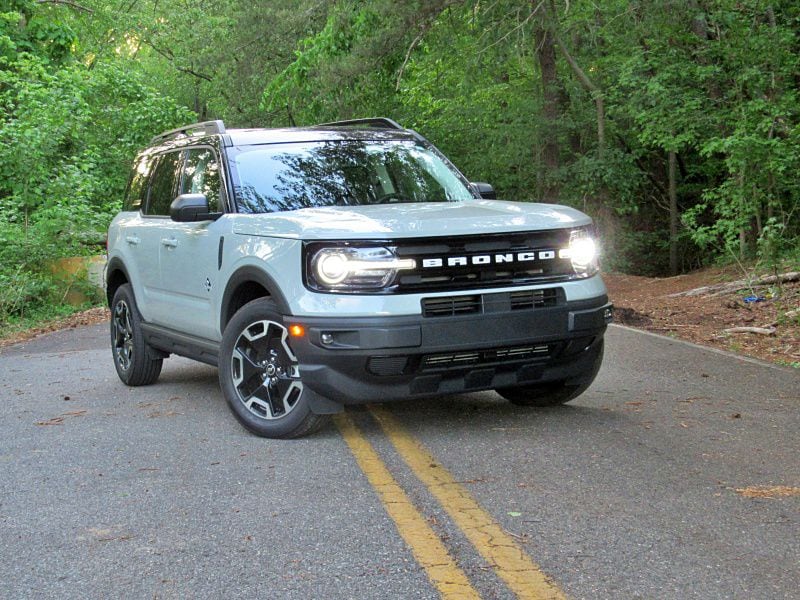
Photo by Brady Holt
Competitors to Consider
The most natural rival to the Ford Bronco Sport is the Jeep Compass. They’re both smaller, more off-road focused, and more powerful than most compact crossovers. The Ford has sportier steering and handling on pavement, along with a bigger cargo hold and smoother cooperation between its engine and transmission. The Jeep gets better gas mileage, has a more luxurious and high-tech dashboard, and a bigger backseat. And while the Bronco Sport goes for a rugged-SUV style in line with the big Bronco, the Compass emulates the Jeep Grand Cherokee's classy-luxury looks rather than looking like a mini Wrangler. You’ll choose your own favorite on that front.
We’d also shop the Bronco Sport against the Subaru Forester and off-road versions of the Toyota RAV4. These crossovers are slower and less agile than this poised, peppy Ford, but they’re roomier. And if you’re just looking for well-rounded small SUVs, our favorites include the roomy and polished Nissan Rogue and Honda CR-V; they make no pretenses of being anything but comfortable, functional, polished on-road crossovers, but they do it well – and admittedly better than the smaller Bronco Sport.
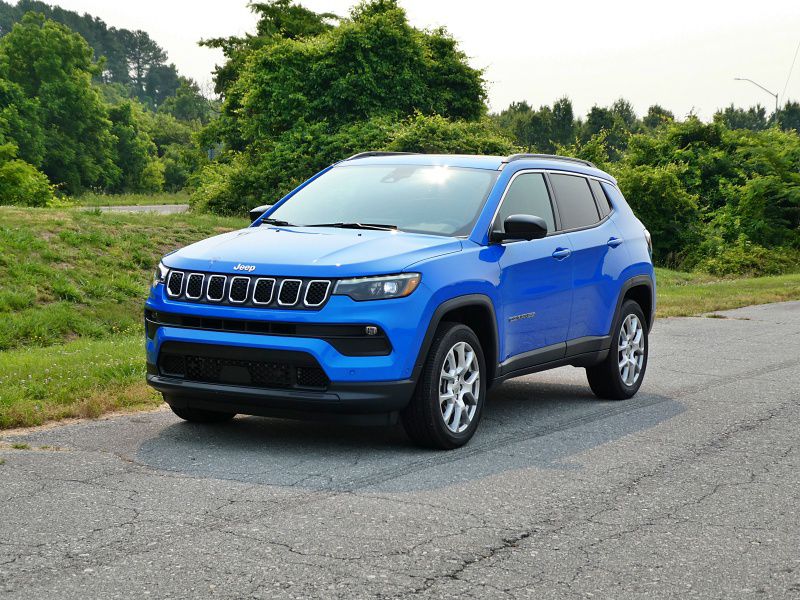
Photo by Brady Holt
Character Without All the Compromises
If the Bronco Sport doesn’t win you over with its retro and utilitarian shape or its hardy interior details, we think you’ll probably buy something else. Sure, you might like how it drives, but there are other rivals that drive well while offering more interior space and better gas mileage for the money.
But if you do like the Bronco Sport, take heart that this isn’t an SUV that forces you into painful compromises. It provides a dose of character and capability without beating you up over bumps, when you gas it up (at least based on our real-world mileage), or when you make your monthly payment. If you don’t need a bigger backseat or cargo hold, it’s a solid compact crossover even before you consider its unique appeal.
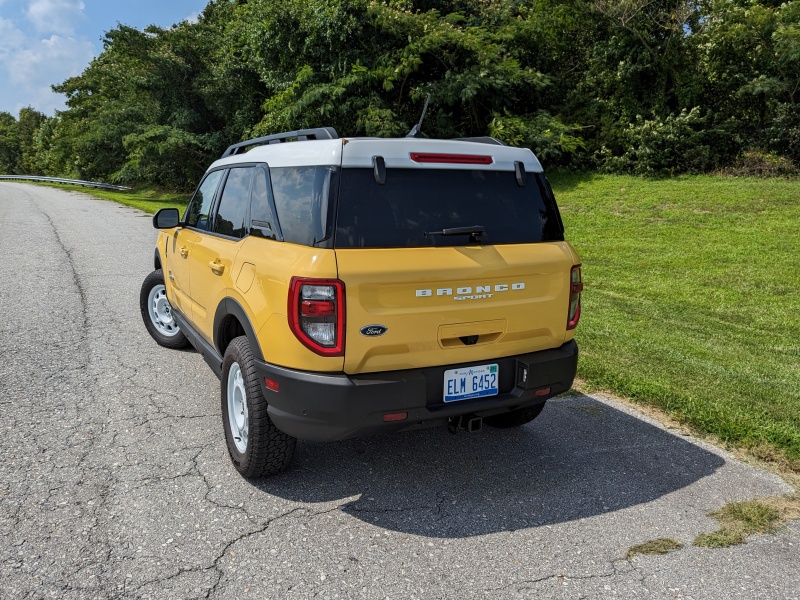
Photo by Brady Holt